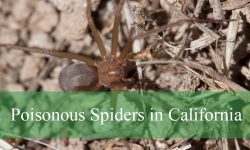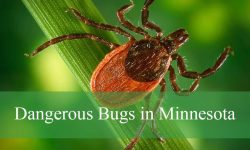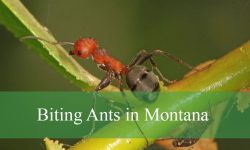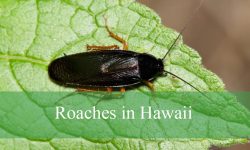Texas landscapes are rich with fascinating insects, and among them are several caterpillars that look soft and harmless yet conceal painful venomous spines. These deceptive creatures often blend perfectly with leaves and branches, making accidental contact easy.
Gardeners, hikers, and nature enthusiasts frequently encounter these stinging species during warm months when caterpillar activity peaks. Their bright colors and fuzzy textures serve as warnings, signaling their toxic defense mechanisms against predators.
This detailed guide introduces seven poisonous caterpillars found across Texas, complete with identification details, sting effects, feeding habits, and host plants. Recognizing these species is the best way to prevent painful encounters while enjoying nature safely.
Types of Poisonous Caterpillars Found in Texas
Spiny Oak-Slug Caterpillar (Euclea delphinii)
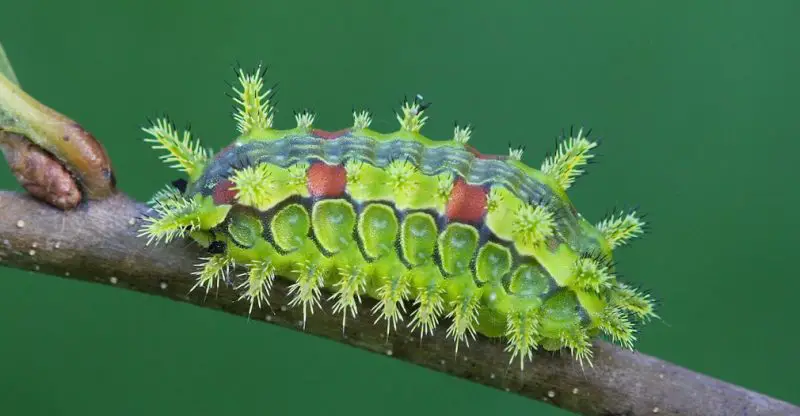
The Spiny Oak-Slug Caterpillar is one of the most visually striking stinging caterpillars in Texas. Small in size—typically about one inch long—it is easily recognized by its vivid green body adorned with patches of blue, orange, and yellow. The surface of the caterpillar is covered with clusters of sharp, branched spines that contain venom, providing an efficient means of defense against predators. Despite its small stature, it can deliver a sting that surprises anyone who touches it.
When contact occurs, the venomous spines embed in the skin, causing immediate burning or stinging pain followed by redness, swelling, and sometimes itching. The reaction usually subsides within a few hours, but for people with sensitive skin, discomfort may persist longer. Unlike the Puss Caterpillar’s severe sting, the Spiny Oak-Slug’s venom produces moderate irritation that is more comparable to a bee sting, though it is still best avoided.
This caterpillar thrives in East Texas and occasionally in Central Texas, especially during late summer when temperatures are warm and humidity is high. Its preferred habitats include woodlands and suburban gardens with an abundance of broadleaf trees. Common host plants are oak, cherry, sycamore, and chestnut trees, though they may also be found on decorative garden shrubs. Their coloration helps them blend into the foliage, making accidental contact a real possibility for gardeners and hikers alike.
The Spiny Oak-Slug Caterpillar eventually pupates into a small, brown moth, which is far less conspicuous than its larval form. While these caterpillars do not generally cause widespread plant damage, their stinging spines make them a nuisance in areas where people frequently come into contact with low tree branches or ornamental shrubs. Wearing protective gloves and long sleeves when working outdoors can help prevent the painful surprise of an encounter with this deceptively beautiful species.
Puss Caterpillar (Megalopyge opercularis)
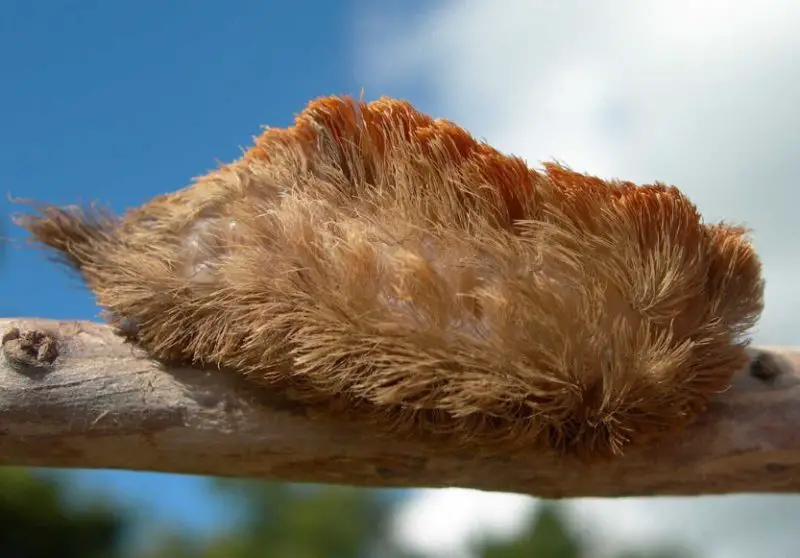
The Puss Caterpillar, also known as the Asp caterpillar, is notorious for being the most venomous caterpillar in North America. Despite its deceptively cute, furry appearance that resembles a tuft of cat hair, this insect hides a dangerous secret beneath its soft exterior. The caterpillar’s body is covered in silky hairs that range in color from gray to orange, concealing rows of sharp venomous spines capable of delivering an excruciating sting. When touched, these spines inject venom that causes immediate, intense pain that radiates through the affected limb.
The symptoms from a sting can include burning sensations, swelling, nausea, headaches, and sometimes difficulty breathing or chest pain. In severe cases, the pain has been compared to a bone fracture or a severe burn, often lasting for hours. Due to their small size and invitingly soft appearance, accidental contact often occurs when someone brushes against them while gardening or handling tree branches. Children and pets are particularly at risk because of their curiosity toward the caterpillar’s furry look.
Puss Caterpillars are typically found on oak, elm, sycamore, citrus, and rose bushes throughout southern and central Texas. They thrive in warm, humid environments and are most active from late spring through early fall. During this time, adult flannel moths lay eggs on the underside of leaves, leading to a new generation of venomous larvae within a few weeks.
These caterpillars feed primarily on the leaves of their host trees, sometimes appearing in large numbers that can cause noticeable defoliation. Gardeners should inspect foliage regularly and wear gloves when pruning or handling branches to avoid painful encounters. Their camouflage-like coloration helps them blend in with the foliage, making them difficult to spot until it’s too late.
Saddleback Caterpillar (Acharia stimulea)
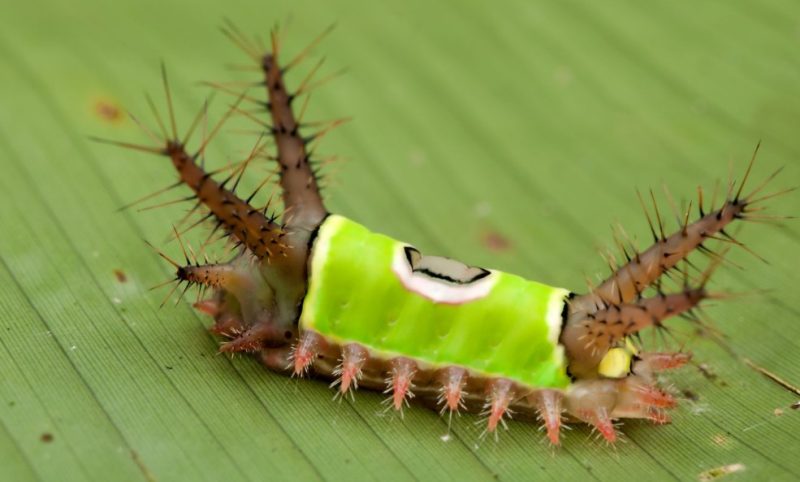
The Saddleback Caterpillar is one of the most easily recognized stinging caterpillars due to its unique and vibrant pattern. Its body is primarily green with a distinctive brown patch in the middle, bordered by white, giving the appearance of a miniature saddle—hence its name. This caterpillar’s appearance may seem harmless or even decorative, but its venomous spines deliver a painful sting that should never be underestimated. These spines, located on the sides and ends of the body, are connected to venom glands that release toxins upon skin contact.
When touched, the stinging sensation is immediate and intense, often followed by redness, swelling, and a burning rash that may last for several hours. Some individuals experience dizziness, headaches, or nausea after being stung. While symptoms are rarely life-threatening, they can cause extreme discomfort, and medical attention may be needed in cases of allergic reactions. The Saddleback Caterpillar is a prime example of how deceptive bright coloration in nature often serves as a warning to predators.
This species feeds on a wide variety of plants, making it common in both natural and cultivated areas. Its host plants include corn, oak, maple, hibiscus, and roses, and it is particularly widespread in East and Central Texas during the summer months. The larvae are often found on the undersides of leaves or in garden vegetation, where they blend well with their surroundings.
The Saddleback Caterpillar’s lifecycle begins when adult Slug Moths lay eggs in clusters on leaves during late spring. By mid to late summer, the larvae mature and begin feeding voraciously, often causing visible leaf damage. Gardeners are advised to inspect plants carefully before pruning or harvesting, as this small but dangerous caterpillar can easily hide among dense foliage.
Io Moth Caterpillar (Automeris io)
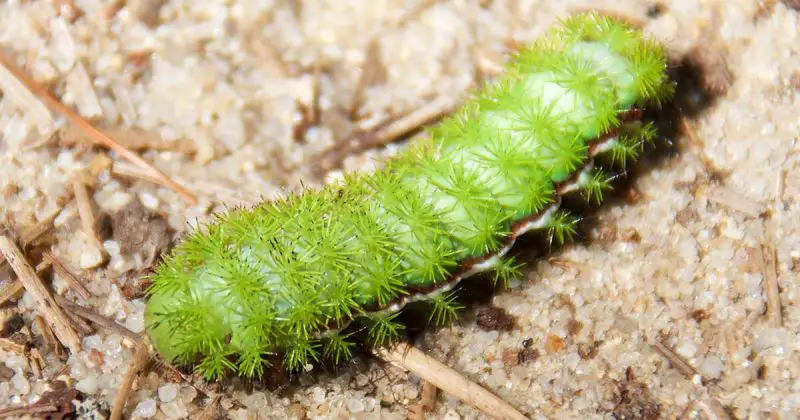
The Io Moth Caterpillar is a striking species with an unmistakable appearance and potent defensive capabilities. Its bright lime-green body is adorned with numerous branched spines tipped with venom, forming an effective deterrent against predators. When threatened or handled, these spines easily break through the skin, injecting toxins that cause sharp, burning pain followed by redness and swelling. The discomfort typically subsides within a few hours, but in some cases, welts and itching can persist longer.
Adult Io Moths are equally remarkable, displaying large “eye spots” on their hind wings that serve as a defense mechanism to startle birds or other predators. This caterpillar undergoes several molts, each stage growing more vibrant and spiny. As they mature, Io Moth Caterpillars can reach lengths of up to 2.5 inches, making them one of the larger stinging species in Texas.
These caterpillars have a wide range of host plants, including hackberry, willow, redbud, clover, and corn. They are most commonly found in East and South Texas, thriving in humid environments near wooded areas, gardens, and fields. Their presence is most noticeable from late summer through early fall when they feed heavily in preparation for pupation.
The venom of the Io Moth Caterpillar is not typically dangerous to humans, but its sting is extremely unpleasant. Contact often occurs when people accidentally brush against them while working outdoors or collecting leaves. Wearing gloves and long sleeves can help prevent encounters, especially in regions where they are common. Though their beauty may attract attention, these caterpillars should be admired from a safe distance.
Buck Moth Caterpillar (Hemileuca maia)
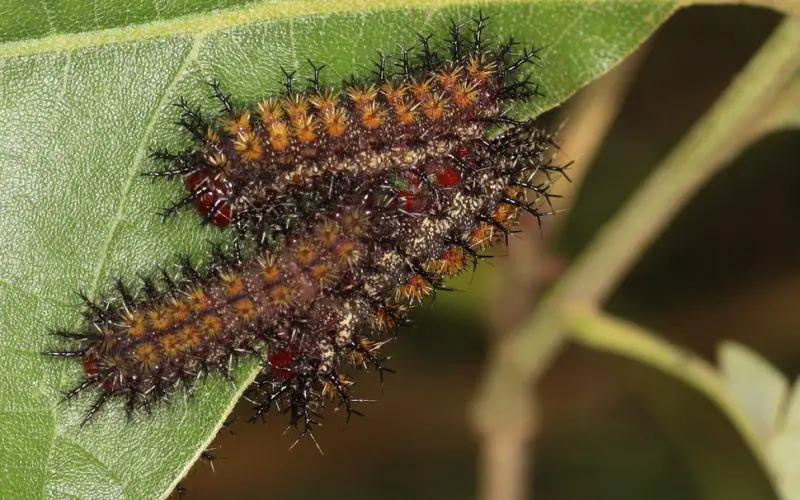
The Buck Moth Caterpillar is one of the largest and most formidable stinging caterpillars found in Texas. Its body is typically dark brown or black with rows of white dots running along its length, and it is covered in sharp, branching spines that can inject venom upon contact. Mature larvae can reach lengths of up to 2.5 inches, making them highly visible as they crawl along tree trunks or branches in search of food. Despite their intimidating appearance, they play an important ecological role as part of the oak forest ecosystem.
When touched, the spines break the skin and release venom that causes intense burning, itching, and the formation of red, painful welts. The reaction may last for several hours, and in some individuals, it can lead to nausea or allergic symptoms. Their large size and spiny texture make them particularly hazardous to people working outdoors or children playing near oak trees where they often gather in groups. In severe cases, medical attention may be necessary to manage pain and swelling.
Buck Moth Caterpillars primarily feed on the leaves of oak trees, especially post oak and live oak, which are abundant across central and eastern Texas. They tend to appear in late spring and early summer, forming large feeding clusters that can strip entire branches of foliage. After feeding, they descend to the ground to pupate in the soil, where they remain until emerging as adult moths in the fall.
These caterpillars are most often encountered in wooded areas, parks, and neighborhoods with mature oaks. Homeowners should exercise caution when collecting firewood, pruning trees, or walking barefoot near fallen leaves. Because of their size and spiny covering, Buck Moth Caterpillars are hard to miss, but it’s best to keep your distance and avoid direct contact. Their presence serves as a reminder that even seemingly ordinary outdoor environments in Texas can harbor hidden dangers.
Hag Moth Caterpillar (Phobetron pithecium)
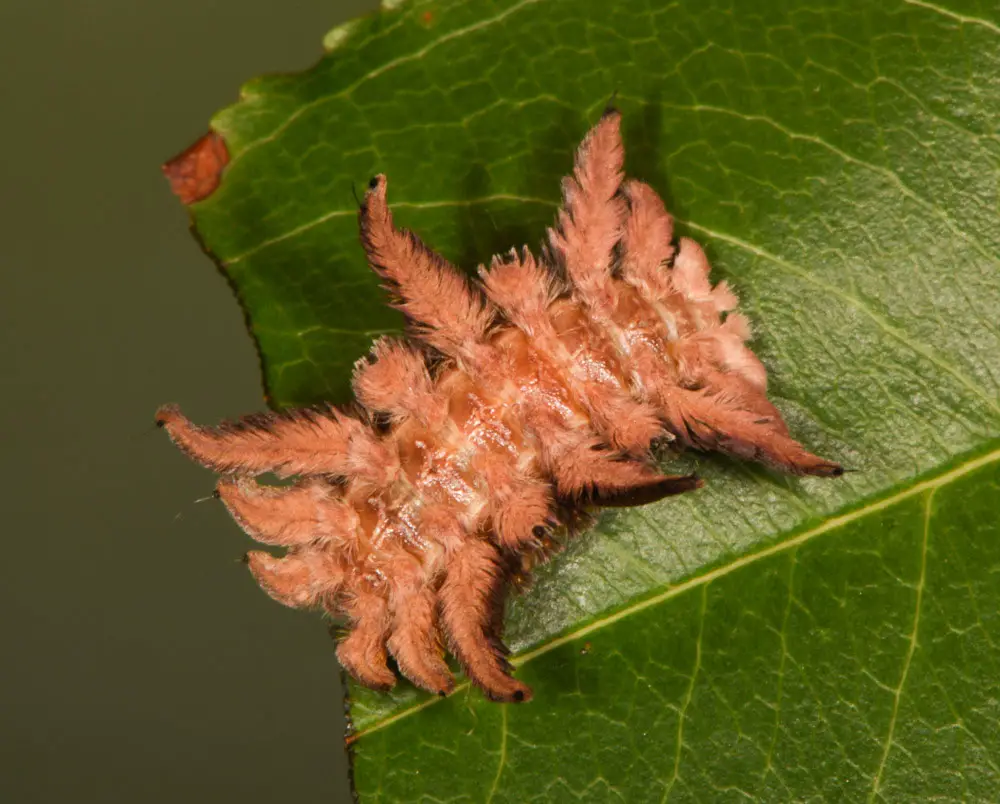
The Hag Moth Caterpillar, also known as the Monkey Slug Caterpillar, is one of the most unusual and distinctive caterpillars found in Texas. Its strange appearance includes six pairs of hairy, tentacle-like appendages that extend from its flattened body, making it look more like a small, fuzzy octopus or a dried leaf than a traditional caterpillar. The coloration varies from brown to tan, helping it blend seamlessly into tree bark and foliage. Beneath its hairy “arms” are venomous spines capable of delivering a painful sting when touched, serving as an effective defense against predators.
The sting from a Hag Moth Caterpillar can cause sharp burning pain, redness, itching, and localized swelling that may last for several hours. While the reaction is typically mild compared to the Puss Caterpillar, individuals with sensitive skin may experience more intense irritation or allergic responses. The caterpillar’s unusual form often attracts curiosity, which unfortunately leads to accidental contact—especially among children or gardeners who mistake it for a harmless bit of leaf litter.
These caterpillars are most frequently found in East and Central Texas, where they inhabit woodlands, orchards, and gardens. They prefer trees such as apple, oak, dogwood, hickory, and elm. The larvae usually appear from mid-summer through early fall, clinging to the undersides of leaves where their coloration provides perfect camouflage. The adult moth, known as the Hag Moth, is equally odd-looking, with a furry, broad body and small wings that make it appear almost bat-like.
The Hag Moth Caterpillar’s diet consists of a wide range of hardwood tree leaves, and while they are not typically present in large enough numbers to cause major defoliation, their stinging nature makes them an unwelcome guest in gardens. It is advisable to handle foliage with gloves when pruning or inspecting infested trees. Despite its eerie look, this caterpillar is a fascinating example of how evolution can produce strange yet effective defense mechanisms in the natural world.
White-Marked Tussock Moth Caterpillar (Orgyia leucostigma)
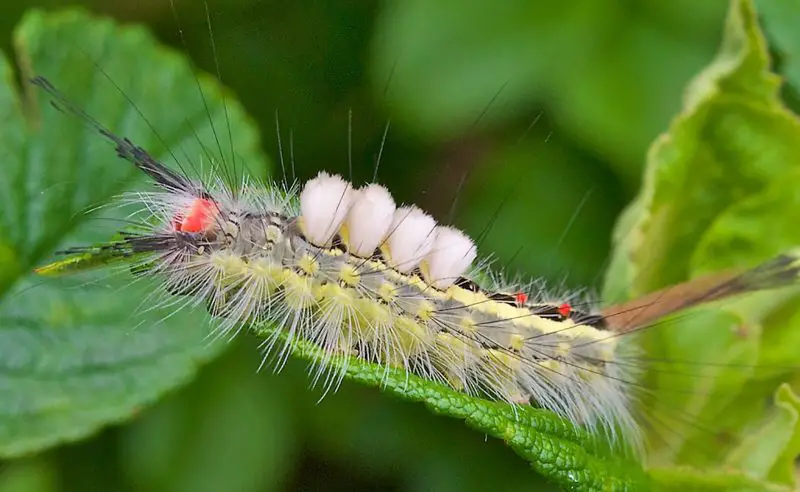
The White-Marked Tussock Moth Caterpillar is one of the most commonly encountered hairy caterpillars in Texas and is instantly recognizable by its bright, contrasting colors. Its fuzzy body features white and yellow hairs, red spots, and four distinctive white tufts on its back that resemble miniature paintbrushes. It also has two long black hair “pencils” at the front and one at the rear, giving it a dramatic, bristly appearance. Although it looks soft and inviting to touch, the hairs contain irritants that can cause uncomfortable skin reactions.
While not as venomous as the Puss or Saddleback Caterpillars, contact with the White-Marked Tussock Moth Caterpillar can result in itchy rashes, redness, and small raised welts. The irritation is caused by histamine-like compounds in the hairs, which act as a mild toxin. In most cases, the reaction is minor and can be treated with over-the-counter creams or antihistamines, but sensitive individuals may experience more severe discomfort. The irritation can linger for several hours, especially if the hairs break off and remain embedded in the skin.
These caterpillars are abundant throughout Texas, especially in urban and suburban environments where their favorite host plants are plentiful. They feed on a wide variety of trees and shrubs, including oak, maple, elm, birch, and ornamental species such as rose and apple. Outbreaks occasionally occur when populations grow large enough to defoliate entire trees, though this is rare in residential areas. Their adaptability makes them one of the more persistent species in Texas landscapes.
The lifecycle of the White-Marked Tussock Moth includes overwintering in the egg stage, with caterpillars emerging in spring and feeding heavily through early summer. The adult moths are small and grayish-white, with females being flightless. While their stings are mild compared to other venomous species, their widespread presence means that accidental contact is common. Wearing gloves while gardening or trimming shrubs is a simple precaution that can prevent irritation from this deceptively fuzzy insect.
Tips to Avoid Poisonous Caterpillar Stings in Texas
Learn to Identify Common Species
The best way to protect yourself is to learn what these caterpillars look like. Familiarize yourself with the most venomous species in Texas, such as the Puss Caterpillar, Saddleback Caterpillar, Io Moth Caterpillar, and Buck Moth Caterpillar. Pay attention to their distinctive features—furry coats, bright markings, or unusual shapes. By knowing what to look for, you can avoid touching them accidentally while outdoors or gardening.
Wear Protective Clothing Outdoors
If you are working in the garden, trimming trees, or hiking through wooded areas, always wear gloves, long sleeves, and pants. Many stings occur when people brush against caterpillars hidden on branches, leaves, or garden plants. Light-colored clothing also makes it easier to spot caterpillars crawling on you before they cause harm.
Check Before Handling Plants and Trees
Inspect foliage, garden furniture, and even outdoor toys before use—especially during late spring to early fall, when most species are active. Shake out towels, gloves, and clothing that may have been left outside. Many caterpillars camouflage perfectly with their surroundings, so a quick visual inspection can prevent painful encounters.
Keep Children and Pets Away
Children and pets are at high risk because they’re naturally curious and may try to touch or play with a fuzzy caterpillar. Teach children to look but not touch, and keep pets away from garden areas where these insects are common. A sting can cause serious pain and allergic reactions in small animals.
Treating a Caterpillar Sting Safely
If stung, use adhesive tape to lift out any embedded spines carefully, then wash the affected area with soap and water. Apply an ice pack to reduce swelling and use over-the-counter pain relievers or antihistamine creams to relieve itching and redness. If symptoms such as difficulty breathing, nausea, or dizziness occur, seek medical help immediately, as these may indicate a severe allergic reaction.
FAQs about Poisonous Caterpillars in Texas
What time of year are poisonous caterpillars most active in Texas?
Most venomous caterpillars in Texas are active from late spring through early fall. This is when moths lay their eggs and the larvae feed on fresh foliage. Warm, humid conditions in summer encourage rapid growth and higher activity, so outdoor caution is especially important during these months.
Are all hairy caterpillars dangerous?
No, not all hairy caterpillars are venomous. Some have harmless hairs, while others, like the Puss or Saddleback Caterpillars, hide venomous spines beneath their fur. As a rule of thumb, it’s best to avoid touching any fuzzy or brightly colored caterpillar, as many use these traits as warnings to predators.
Can caterpillar stings cause long-term effects?
Most caterpillar stings cause temporary pain, redness, and itching that subside within a few hours to a couple of days. However, individuals with allergies or sensitive skin may experience more severe or prolonged reactions. Repeated exposure can also increase sensitivity over time, making future stings more painful.
What should I do if my pet gets stung by a caterpillar?
If your pet shows signs of distress, drooling, or pawing at the mouth after contact with a caterpillar, rinse the affected area gently with cool water and contact a veterinarian immediately. Do not try to remove spines with your fingers—use tweezers carefully or sticky tape to lift them out if visible.
How can I control caterpillar populations in my yard?
Regularly inspect trees, shrubs, and garden plants for clusters of eggs or small larvae. You can remove them manually with gloves or prune affected branches. For larger infestations, use natural predators like birds or apply a biological pesticide containing Bacillus thuringiensis (Bt), which targets caterpillars without harming beneficial insects. Keeping your yard clean and trimmed will also reduce the likelihood of caterpillar outbreaks.
Are these caterpillars dangerous to crops or trees?
While most poisonous caterpillars in Texas do feed on tree leaves, they rarely cause lasting damage unless populations grow unusually large. Species like the Buck Moth and Io Moth Caterpillars can defoliate sections of oak or willow trees, but trees generally recover the following season. The primary concern is their sting, not significant agricultural harm.
Do poisonous caterpillars turn into dangerous moths?
No, adult moths that emerge from these caterpillars are harmless to humans. The venomous stage exists only in the larval (caterpillar) form. Adult moths no longer have stinging hairs or spines, making them safe to handle or observe once they’ve completed metamorphosis.

